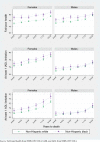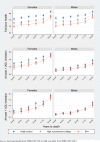How does it all end? Trends and disparities in health at the end of life
- PMID: 35895597
- PMCID: PMC9328500
- DOI: 10.1371/journal.pone.0267551
How does it all end? Trends and disparities in health at the end of life
Abstract
Objectives: To consider trends and disparities in end-of-life health in the US.
Methods: I use data from the National Health Interview Survey, linked to death records through 2015, for respondents who died at ages 65+ to compare the prevalence of three health outcomes in the last six years of life across time, sex, age, race, and educational attainment. Self-rated health (SRH) is available for respondents interviewed in years 1987-2014, while information on activities of daily living (ADL) and instrumental activities of daily living (IADL) is available for the period 1997-2014.
Results: By the end of the study period, individuals reported two fewer months of fair/poor health at the end of life than those dying in earlier years. In contrast, time lived with at least one activity limitation at the end of life generally remained comparable. Compared to men, women on average reported an additional year of living with an IADL limitation before death, and an additional eight months with an ADL limitation. Despite sex differences in disability, both sexes reported similar periods of fair/poor SRH before death. Similarly, while individuals who lived to older ages experienced a longer disabled period before death than individuals who died at younger ages, all age groups were equally likely to report fair/poor SRH. Black adults and adults with less formal schooling also spent more time with an end-of-life disability. For men, these racial and socioeconomic disparities lessened as death approached. For women, inequalities persisted until death.
Discussion: These findings suggest that despite increasing life expectancy, the period of poor health and disability prior to death has not recently been extended. Black women and women with less than a high school degree, require extended support at the end of life.
Conflict of interest statement
The author has declared that no competing interests exist.
Figures




References
-
- Riffe T., Chung P. H., Spijker J., & MacInnes J. (2016). Time-to-death patterns in markers of age and dependency. Vienna Yearbook of Population Research, 14, 229–254.
MeSH terms
Grants and funding
LinkOut - more resources
Full Text Sources
Medical

